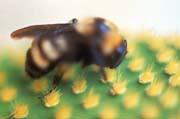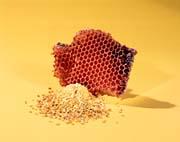The stings in the tail for orthodox medicine
 Bee propolis has always had a pretty healthy image. After all, honey was one of the staple foods in the Middle Ages and is known to have significant anti-viral and anti-fungal benefits. Only recently, we covered a story in icon that Christie Hospital, Manchester was to use Manuka honey for patients who had had chemotherapy or radiotherapy and were suffering from infections of the throat and mouth.
Bee propolis has always had a pretty healthy image. After all, honey was one of the staple foods in the Middle Ages and is known to have significant anti-viral and anti-fungal benefits. Only recently, we covered a story in icon that Christie Hospital, Manchester was to use Manuka honey for patients who had had chemotherapy or radiotherapy and were suffering from infections of the throat and mouth.
What is Bee Propolis?
Propolis is a natural compound produced by bees from the buds of plants and mixed with wax and resin. It is used to repair the hive, and to protect it from predators like viruses, bacteria, fungi and various microbes and diseases. It maintains the temperature and health of the hive (Park et al 2002).
Not surprisingly it can be extremely useful in fighting various infectious diseases. A range of safe and positive effects has been identified - for example, it is highly effective with:
The actual content of bee propolis depends on the geographic location of the bees and the time of year (Banskota et al 2000). Propolis often comprises more than 180 natural compounds, many of which are concentrates of powerful antioxidant plant flavenoids and phenols. This finding, through chromatographic analysis for example, has led to many new and research-proven benefits over the last 8 years. (Castaldo and Capasso, 2002)
Bee propolis is now also known to have:
anaesthetic benefits
immuno-modulating benefits
anti-inflammatory benefits
antioxidant benefits
cardiovascular benefits
cancer prevention and treatment benefits
Brazilian bee propolis (Green propolis from Baccharis Dracunculifolia) has been the subject of a number of many serious clinical studies, and according to PubMed, accounts for over 26 per cent of all new research. The next group of major researchers is in Japan.
Because the ingredients of bee propolis can vary greatly, I will confine the rest of this article to Brazilian green propolis. Much of the research detail comes from an article published in the International Journal of Cancer Research 3 (1); 43-53 2007.
Anti-Cancer Benefits?
It seems Brazilian bee propolis may have significant and varied anti-cancer benefits, some of which will surprise many orthodox experts. Overall, research has indicated benefits in each of the following areas of the cancer process:
Furthermore, it has been shown in research to enhance the benefits of chemotherapy and radiotherapy, having a protective effect on healthy cells and an enhancing effect on chemotherapy action.
Do we think it is a cancer ’cure’? No. At CANCERactive we think no single compound (Drug or natural) is likely to be a cure for cancer. However it may be useful as art of your overall programme, because of the wide variety of natural compounds it contains..
(i) Anti-inflammatory action?
Inflammation is a usual precursor to cancer and may be caused by a number of factors such as eicosanoids (e.g. Prostaglandins), cytokines (e.g. leukotrines), quinines, free radicals histamines and serotonin. Propolis has been shown to inhibit prostaglandin, leucotrine and histamine release. (Khayyal et al 1993; Mirzoeva and Calder 1996; Hepsen et al 1999. Indeed all these inflammatory conditions have been suppressed in clinical studies - and in each case the response was as good as the recommended prescription drug (Menezes et al 1999). Propolis was even found to overcome formaldehyde induced arthritis. Typical active ingredients were the flavenoid hesperidins (Hata and Beyer 2004).
(ii) Anti-viral; anti-yeast?
Various research studies have confirmed bee propolis effectiveness against all the principle strains of Staphylococcus, Escherichia coli, salmonella, E coli, candida albicans and even HIV. A number of flavenoids seem particularly important, especially kaempferol, pinocembrin and galangine. Again controls were taken using prescription drugs such as AZT the anti-AIDS drug. Moronic acid in propolis had significant anti-HIV effect, out-scoring the AZT drug.
 If you are already thinking of buying Bee Propolis, you might like to look at the Natural Selection Product of Choice. You can do this by clicking here.
If you are already thinking of buying Bee Propolis, you might like to look at the Natural Selection Product of Choice. You can do this by clicking here.
(iii) Wound Healing?
Astragalus Propolis has been found to have antiseptic, anaesthetic and healing powers. It has been shown to have a healing effect in the tissue repair of oral mucosa (Bretz et al 1998) - hence the use of Menuka by Christie Hospital. It is also effective as a 5 per cent mouthwash after dental surgery (Carvahlo 1994). Post operative wounds - for example after cancer surgery - in subcutaneous tissues were more quickly healed with a compress of propolis, honey and comfrey ointment (Magro-Filho 1987).
(iv) Immune Stimulant?
The ester of caffeic acid (CAPE) is one of the main active compounds of propolis, along with the flavenoid ingredients Quercitin and Hesperidine. They seem to have two actions. Firstly, they seem to inhibit cellular growth and secondly, they can increase the presence of certain white immune cells like T-lymphocytes, increasing hydrogen peroxide production without any simultaneous and damaging nitrite production, which usually occurs with macrophage activity. (Than et al 2003; Ansorge et al 2003)
(v) Free Radical Scavenging?
 Flavenoids are known to have powerful antioxidant benefits. Matsushige et al 1996 isolated a compound from propolis to show that it had a stronger antioxidant benefit that vitamins C and E. The Brazilian propolis seems to have stronger antioxidant powers than those of China, Peru and Holland. The antioxidant capacity can prevent the free radicals acting on the cell lipids, proteins and even the DNA.
Flavenoids are known to have powerful antioxidant benefits. Matsushige et al 1996 isolated a compound from propolis to show that it had a stronger antioxidant benefit that vitamins C and E. The Brazilian propolis seems to have stronger antioxidant powers than those of China, Peru and Holland. The antioxidant capacity can prevent the free radicals acting on the cell lipids, proteins and even the DNA.
(vi) DNA Protection?
CAPE - even when used in low doses - can prevent cellular mistakes in healthy cells and induce apoptosis (cell death) in cancer cells. Thus it seems to have a double benefit of protecting healthy cells whilst killing cancer cells. (Chen et al 2003)
Fitzpatrick et al (2001) also showed that propolis could protect healthy DNA and restrict macrophage activity. This selective effect was also shown by Su et al 1995.
(vii) Anti-tumour effect?
The ability to protect healthy DNA was confirmed by Banskota et al 2001, and by Suzuki et al, in 2002. They both also noted that propolis had anti-tumour activity. The ability to kill cancer cells has been shown both in vitro and in animal in vivo studies. The particular ingredient responsible is Artepillin C, which leads to cancer cells DNA fragmentation (Kimoto et al 1998). Kimoto has also shown that intra-tumoural injections of 500 mgs of Artepillin C produced apoptosis and an increase in immune defenses.
CAPE and another 20 ingredients of propolis were tested by Nagaoka et al 2002. 4 were found to cause cancer cell death. Where CAPE was taken orally by mice with lung tumours, a reduction of tumour size of 50 per cent was noted. Researchers similarly tested another group of mice using the drug cisplatine. No difference in effectiveness was noted, but the mice taking the drug had significant weight loss, a side-effect not noted with propolis (Nagaoka et al 2003). It was concluded that CAPE had a cytoxic effect, and could also block the invasive, metastasis noted with these tumours. Further research in Cancer Watch 2012 seems to concur with this.
(viii) Enhancement of orthodox chemotherapy approaches?
Propolis has biological effects that act in synergy with chemotherapy drugs such as 5-fluorouracil (Suzuki et al 2002).Importantly Santos and Cruz 2001 showed that the antioxidant properties of propolis could reduce the side effects caused by chemotherapy drugs without any detriment to the therapeutic effects.
Suzuki researched two drugs in experiments with mice and cancer (mitomicine C and 5- fluoresce) and showed that the combination of drug plus propolis had by far the greatest regression effects especially in advanced stages, over the drugs used on their own. The propolis usage resulted in higher levels of white and red cells and less side effects. The conclusion of the research was that propolis increased the bio-availability of the drugs. The desired effect could therefore logically be achieved on smaller doses and with even less side effects.
Orsolic and Basic (2005) used mice with breast tumours to show antioxidants can enhance the performance of both radiotherapy and chemotherapy, by using water soluble bee propolis. This supports the work of Chan noted above, that CAPE has a cytoxic effect and can cause cell death, whilst protecting the DNA of healthy cells. Chemotherapy agents used in anti-metastatic activity have their benefits enhanced. was again the conclusion. The authors recommended clinical trials should take place as all the indications were for greater effect in radio and chemotherapy, whilst minimising blood cell declines and other side effects.
Padmavathi et al (2005) studied the drug paclitaxel with propolis, in DMBA-induced mice breast cancer and concluded that the two combined suppressed breast cancer, decreased lipid peroxidation, and increased the activities of antioxidant enhanced super oxide dismutase and vitamin C. They concluded that the combination of paclitaxel and propolis offers maximum effect in DMBA-induced breast cancer.
A Concentrated Rainbow Diet?
 Its a wonder oncologists arent all rushing to use propolis - or at least conduct clinical trials. What have they got to lose?
Its a wonder oncologists arent all rushing to use propolis - or at least conduct clinical trials. What have they got to lose?
Unfortunately if these results are borne out in real life, it would explode the myth that they have been uttering for too long - that antioxidants get in the way (are counter-indicated) for their wonder drugs and radiotherapy. We have quoted research in the past in icon from UCLA and MD Anderson (several studies) before saying antioxidants are beneficial to orthodox therapies. Now the research on the use of propolis, with 180 concentrated ingredients, many of which are antioxidants is the final sting in the tail. But will they take notice? Sadly, given the consistency of these findings, its the patients who are losing out if propolis is not used by patients with cancer. The drugs and radiotherapy are less effective, and the side effects are worse.
Hippocrates must be turning in his grave.
Of course, as we have repeatedly told you, one of the best ways to help increase your personal odds of survival is to build a thorough and disciplined diet across all the bases Chris Woollams new book, The Rainbow Diet and how it can help you beat cancer, tells you exactly that, with all the research evidence for natural compounds. Its as if the Bees know! They concentrate 180 natural compounds into their own Rainbow Diet; To read the book review click here. To buy the book

 At last, the definitive, research-based book on how to build a diet to help beat cancer. Click here to read about it.
At last, the definitive, research-based book on how to build a diet to help beat cancer. Click here to read about it.
Bee Propolis Natural Selection
If you are already thinking about buying Bee Propolis you might like to see what is available at the Natural Selection store (although it will not be Brazilian as, at the last count, this was over 180 pounds per pot!) To go to Natural Selection, click here.
Please be clear: At CANCERactive we do not consider the above compound to be a cure for cancer, despite what the research says or experts doing the research may claim. The above, is an article on the compound from published research and expert opinion in the public domain. At CANCERactive we do not believe that any single compound (drug, vitamin, whatever) is a cure for cancer. We believe that people can significantly increase their personal odds of survival by building an Integrated Programme of treatments. Equally, cancer prevention is best practiced through a width of measures.